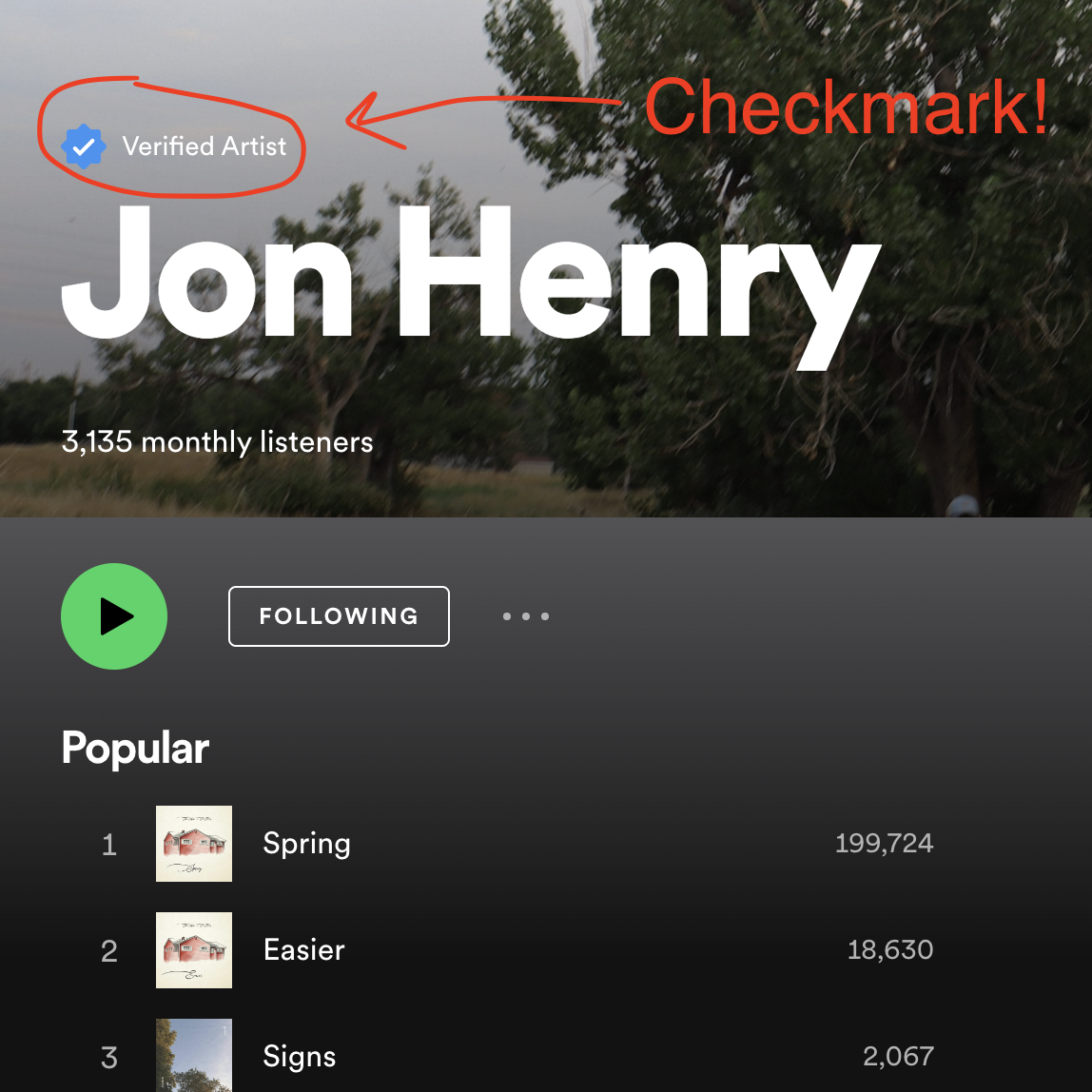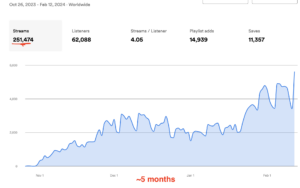What’s more important than online credibility for a creative person? Sometimes it seems that the beauty and complexity of your craft get overshadowed by the number of likes, interactions, and followers you have on whichever social media platform you use.
Last month I hosted an event in London, and while the event page on Facebook showed me that 20 people were attending the event, we had 150 turning up on the evening. So how much should you, an artist, care about your online credibility? The answer is, unfortunately, a lot: because even if there’s a discrepancy between your digital and physical fanbase, your online presence is how your artistry gets introduced to a worldwide audience.
Enough rambling. Today I want to talk about blue checkmarks, and in particular, the one that makes you a verified artist on the most popular streaming platform: Spotify. Why should we talk about this? Because this blue icon gives you credibility and ensures listeners, you’re a legitimate artist. Isn’t that what we all want, after all?
In this article, I created a guide for you to follow and get verified on Spotify. Learn why you should get verified and all the benefits you will have after getting your blue checkmark.
Let’s dive in!
What does it mean to be a verified artist?
To be verified on Spotify means that you are the profile owner, and no one is pretending to be you. As a verified artist, you get access to Spotify for Artists, which allows you to edit your artist’s profile, add pictures, set tour dates, pitch to curator’s playlists, access analytics on your music, access wrapped for artists and many other features.
Once you have the blue verification checkmark, you will be recognized as an official Spotify artist. Spotify curators will more likely consider your music to add to their playlists and make fans trust your songs are legit.
Most popular artists are verified by themself, their managers and teams, or record labels and distributors. As an independent artist, you can request your verification by claiming your artist page.
It may sound as if verification is only about displaying the badge on your profile for everyone to know, but it’s more than that. For example, many playlist curators will only place verified artists on their playlists. Besides, you’ll have access to more promotional tools for your music within Spotify.
About Spotify for Artists
Spotify offers musicians a free service called Spotify for Artists. It provides many useful tools for promotion, pitching, and trustworthy information about your listeners and music streams.
With Spotify for Artists, you can expand your audience, analyze data about your music on the streaming platform, and provide insights on promoting your music and who is listening to your songs.
You can manage your artist profile through Spotify for Artists to make it look professional. Once you get access to Spotify for Artists and the verified badge, you must constantly update your profile whenever there’s a new release, tour, or career milestone.
Having activity on your profile means you are an active Spotify artist, even if you don’t have many songs released per month. Make sure your new audience can find up-to-date information when they land on your profile.
To access Spotify for artists, you need to claim your profile or get an invitation from your record label, manager, or distributor. Claiming your artist profile is the first step to accessing Spotify for Artists and getting verified on Spotify.
Before submitting your request for verification
Unlike your social media profiles, your Spotify profile can’t be created just after you have your first song recorded or your first show at a local venue.
You can’t “create” your artist profile. You will need at least two things before thinking about verification: you need to have music released on Spotify or about to be released and a distributor that delivers your music to Spotify.
Have your song, demo, or album recorded and mastered.
I know this may be obvious, but it’s good to remember that the first step is creating music. You cannot claim your profile and request verification if you don’t have music on Spotify.
Before uploading music on Spotify, make sure your master meets the loudness and normalization requirements of the platform. If you have audio engineers mastering your song, let them know you will upload your music to a streaming platform, and they’ll know what to do.
If you use mastering services, they usually have options to download the mastering for streaming and digital stores. But if you are mastering your own, you should consider Spotify’s mastering tips.
Once you have your master, the next step is to find a distributor.
Have a distributor to get your music on Spotify.
Distributors are companies that get records to online music stores and streaming platforms. Before digital distribution was the norm, these companies would agree with labels to get the albums to retailers and take a portion of the revenues.
With digital distribution, many companies offer distribution services to artists, allowing them to keep 100% of their revenues. Digital distribution has significantly changed with the rise of streaming platforms, especially for unsigned artists.
It’s impossible to upload songs directly to Spotify from your artist page. Distributors are still needed to get your songs on streaming platforms and help you collect royalties.
If stuck on this step, you can look at Spotify’s recommended distributors. Many known companies, such as DistroKid, CD Baby, TuneCore, and Amuse, are on their list.
Do your research on distributors before signing up with one. Depending on your needs, you may choose a distributor over the other. Some include music promotion in their service for a fee, while others are free with basic features.
Now you can claim your artist’s page and apply for verification.
How to get verified on Spotify: a step-by-step guide
Not long ago, the verification process was complicated for indie artists. The blue checkmark was only available for an artist signed to a label with thousands of streams and followers.
Back in the day, Spotify required you to have at least 250 followers to apply for verification. It was harsh for new artists to get to 250 followers, needing to promote their music to achieve it. Without the verification, playlist curators would not even listen to their songs, leading naïve artists to scammers who request money in exchange for playlist placement.
Thankfully, Spotify has enabled everyone to apply for verification quickly and easily.
Step 1. Go to Spotify for artists.
First, you need to go to the Spotify for artist’s page and click on the top right corner where it reads “Get access” to get to the claim page.
Contact your label or manager to see if they can access your Spotify for artists. Usually, record labels claim their artists’ profiles and can give you access to your Spotify for artists with an invitation to the team. If that’s your case, you don’t have to do the request process; you should be verified already by your label.
Step 2. Choose the right team.
You’ll be redirected to the Claim page, where you’ll need to select if you are an artist, manager, or team member of a record label. Just click on the option that best describes you (for indie artists and bands, choose “Artist or manager”).
Step 3. Sign-up or log in to Spotify.
If you haven’t logged in before, the platform will ask you to log in to Spotify or sign-up. You can use the Spotify account you use as a listener. After logging in or creating a new one, you’ll return to the Claim page. Click on Continue to proceed.
The next screen will show your account picture, email, and username. At this moment, you can change to a different account if needed. Click next when you are ready.
Step 4. Search and claim your artist’s profile.
Use the search box to type your name, artist name, or band name and select your profile from the results list.
If your music is not on Spotify yet, but you already uploaded it on your distributor’s profile, look for your Spotify artist URI link and paste it into the search box.
If you are a manager, wait until you have access to the first profile before claiming more than one artist at a time.
Step 5. Fill in the request.
You must fill in other information like your full name and business email. You will be asked to connect your Spotify profile to your social media platforms or website to verify your identity.
Verify that all your information is correct, read Spotify’s terms and conditions, and check the box to accept them and proceed.
Step 6. Wait for the verification.
After clicking “Submit,” you must wait while Spotify reviews your request. You may need to wait a few days to get a response because they evaluate every request individually. In the meantime, you could be getting ready to personalize your profile once you have access.
Why get verified?
Being a verified artist on Spotify comes with advantages. You’ll have access to some exciting features to improve your artist’s profile. Let’s look at the more relevant benefits of getting your profile verified.
Get access to your statistics.
Thanks to Spotify for Artists, you can see stats on all your music, total streams, specific releases, and how well your songs perform on playlists. Find out about your audience and which countries are streaming your music the most, and use this data to get more control over how to approach your future releases.
Control your profile.
You’ll be able to control all the information you want to display on your profile. An artist’s path can change over time, and you might need to change your artist’s name at some point, update your biography, add a new picture or remove old ones and update your social media links.
Some other things you can add to your profile are:
- Artist’s pick.
- Featured playlists.
- Tour dates.
- Link your merch store.
- Fan support links.
Take your time to get your profile looking professional, as more than just a blue checkmark is necessary to bring attention to your profile. It’s what you share that matters: your music.
Pitch to playlists curators.
With access to Spotify for artists, you can submit your new releases to editorial curators to be placed on any Spotify editorial playlist. Though there are some conditions to meet before submitting a song:
- Submit unreleased music only.
- Submit before your release date, so the editors have enough time to listen and decide.
- Verify your pitch before submitting it. You can edit it up to the release date, but the editors might not notice the change if they have already reviewed the song.
It’s hard to be included in editorial playlists, but you can always pitch to user playlists by contacting them or using a playlists finder. With your verified checkmark, you are letting the owner of the playlists know that you are an official Spotify artist and can be trusted.
Final thoughts on getting verified on Spotify
The verification process is more straightforward than it used to be, so make sure you claim your profile ASAP to enjoy the benefits of being a legitimate Spotify artist.
Remember that Spotify for Artists and the verification is free for anyone who has released music on the platform. Refrain from accepting help from people promising you quick access for a fee. These are often scammers taking advantage of new artists.
Work closely with your distributor if you have any concerns; they usually know the process or have done it for other emerging artists.
Good luck, and stay creative!









